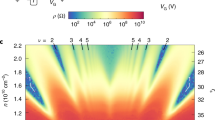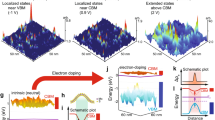Abstract
Two-dimensional (2D) electronic systems can exhibit dramatic drops in resistivity, ρx x, as the temperature T→0, which has renewed debate as to whether 2D systems may have a metallic ground state. The metallic behaviour is only observed in low-disorder systems, where interactions between the carriers are strong. However, the strength of the metallic behaviour is not universal, with decreases in resistivity ranging from a few per cent to an order of magnitude as T→0. Here, we compare the metallic behaviour in 2D systems dominated by long- and short-range disorder. We thereby highlight the pivotal role played by the type of disorder in determining the strength of metallic behaviour in these systems. In doing so, we resolve recent confusion in the literature that has arisen from the application of interaction-based theories of metallic behaviour to 2D systems whose disorder environments are inconsistent with the assumptions made by these theories.
This is a preview of subscription content, access via your institution
Access options
Subscribe to this journal
Receive 12 print issues and online access
$209.00 per year
only $17.42 per issue
Buy this article
- Purchase on Springer Link
- Instant access to full article PDF
Prices may be subject to local taxes which are calculated during checkout




Similar content being viewed by others
References
Abrahams, E., Kravchenko, S. & Sarachik, M. Colloquium: Metallic behavior and related phenomena in two dimensions. Rev. Mod. Phys. 73, 251–266 (2001).
Kravchenko, S. V. & Sarachik, M. P. Metal–insulator transition in two-dimensional electron systems. Rep. Prog. Phys. 67, 1–44 (2004).
Abrahams, E., Anderson, P. W., Licciardello, D. C. & Ramakrishnan, T. V. Scaling theory of localization: absence of quantum diffusion in two dimensions. Phys. Rev. Lett. 42, 673–676 (1979).
Dolan, G. J. & Osheroff, D. D. Nonmetallic conduction in thin metal films at low temperatures. Phys. Rev. Lett. 43, 721–724 (1979).
Uren, M. J., Davies, R. A., Kaveh, M. & Pepper, M. Logarithmic corrections to two-dimensional transport in silicon inversion layers. J. Phys. C 14, 5737–5762 (1981).
Bishop, D. J., Tsui, D. C. & Dynes, R. C. Nonmetallic conduction in electron inversion layer at low temperatures. Phys. Rev. Lett. 44, 1153–1156 (1980).
Kravchenko, S. V. et al. Scaling of an anomalous metal–insulator transition in a two-dimensional system in silicon at B=0. Phys. Rev. B 51, 7038–7045 (1995).
Hanein, Y. et al. The metalliclike conductivity of a two-dimensional hole system. Phys. Rev. Lett. 80, 288–1291 (1998).
Simmons, M. Y. et al. Metal–insulator transition at B=0 in a dilute two dimensional GaAs–AlGaAs hole gas. Phys. Rev. Lett. 80, 1292–1295 (1998).
Yoon, J., Li, C. C., Shahar, D., Tsui, D. C. & Shayegan, M. Wigner crystallization and metal–insulator transition of two-dimensional holes in GaAs at B=0. Phys. Rev. Lett. 82, 1744–1747 (1999).
Hamilton, A. R., Simmons, M. Y., Pepper, M., Linfield, E. H. & Ritchie, D. A. Metallic behavior in dilute two-dimensional hole systems. Phys. Rev. Lett. 87, 126802 (2001).
Li, L., Proskuryakov, Y. Y., Savchenko, A. K., Linfield, E. H. & Ritchie, D. A. Magnetoresistance of a 2D electron gas caused by electron interactions in the transition from the diffusive to the ballistic regime. Phys. Rev. Lett. 90, 076802 (2003).
Noh, H. et al. Interaction corrections to two-dimensional hole transport in the large-rs limit. Phys. Rev. B 68, 165308 (2003).
Pudalov, V. M. et al. Interaction effects in conductivity Si inversion layers at intermediate temperatures. Phys. Rev. Lett. 91, 126403 (2003).
Simmons, M. Y. et al. Weak localization, hole-hole interactions, and the “metal”–insulator transition in two dimensions. Phys. Rev. Lett. 84, 2489–2492 (2000).
Castellani, C., Di Castro, C., Lee, P. A. & Ma, M. Interaction-driven metal–insulator transitions in disordered fermion systems. Phys. Rev. B 30, 527–543 (1984).
Finkel’stein, A. M. Weak localization and coulomb interaction in disordered systems. Z. Phys. B 56, 189–196 (1984).
Altshuler, B. L. & Aronov, A. G. Electron–Electron Interactions in Disordered Systems (North-Holland, Amsterdam, 1985).
Punnoose, A. & Finkel’stein, A. M. Metal–insulator transition in disordered two-dimensional electron systems. Science 310, 289–291 (2005).
Zala, G., Narozhny, B. N. & Aleiner, I. L. Interaction corrections at intermediate temperatures: Longitudinal conductivity and kinetic equation. Phys. Rev. B 64, 214204 (2001).
Proskuryakov, Y. Y. et al. Hole–hole interaction effect in the conductance of the two-dimensional hole gas in the ballistic regime. Phys. Rev. Lett. 89, 076406 (2002).
Gao, X. P. A. et al. Temperature and magnetic-field-enhanced Hall slope of a dilute 2D hole system in the ballistic regime. Phys. Rev. Lett. 93, 256402 (2004).
Olshanetsky, E. B. et al. Conductivity of a two-dimensional electron gas in a Si/SiGe heterostructure near the metal–insulator transition: Role of the short- and long-range scattering potential. Phys. Rev. B 68, 085304 (2003).
Shashkin, A. A., Kravchenko, S. V., Dolgopolov, V. T. & Klapwijk, T. M. Sharp increase in the effective mass near the critical density in a metallic two-dimensional electron system. Phys. Rev. B 66, 073303 (2002).
Yasin, C. E. et al. Interaction correction to the longitudinal conductivity and Hall resistivity in high quality two-dimensional GaAs electron and hole systems. Phys. Rev. B 72, 241310 (2005).
Gold, A. Temperature dependence of mobility in AlxGa1−xAs/GaAs heterostructures for impurity scattering. Phys. Rev. B 41, 8537–8540 (1990).
Clarke, W. R. et al. Fabrication of induced two-dimensional hole systems on (311)A GaAs. J. Appl. Phys. 99, 023707 (2006).
Karpus, V. Theoretical limit of mobility of two-dimensional electrons in GaAs. Semicond. Sci. Technol. 5, 691–694 (1990).
Gornyi, I. V. & Mirlin, A. D. Interaction-induced magnetoresistance: from the diffusive to the ballistic regime. Phys. Rev. Lett. 90, 076801 (2003).
Gornyi, I. V. & Mirlin, A. D. Interaction induced magnetoresistance in a two-dimensional electron gas. Phys. Rev. B 69, 045313 (2004).
Gold, A. Mobility of the two-dimensional electron gas in AlGaAs/GaAs heterostructures at low electron densities. Appl. Phys. Lett. 54, 2100–2102 (1989).
Hamilton, A. R. et al. Reentrant insulator-metal–insulator transition at B=0 in a two-dimensional hole gas. Phys. Rev. Lett. 82, 1542–1545 (1999).
Acknowledgements
This work was funded by the Australian Research Council and the EPSRC. A.P.M. acknowledges an ARC Postdoctoral Fellowship, A.R.H. acknowledges an ARC Professorial Fellowship, and M.Y.S. a Federation Fellowship.
Author information
Authors and Affiliations
Contributions
W.R.C. fabricated the induced SISFET, carried out the low-temperature magnetotransport measurements, carried out data analysis, assisted with the concept and design of the experiment and wrote the paper. C.E.Y. carried out low-temperature measurements of the HHMT and fitted the low-temperature data. A.R.H. conceived and designed the experiments, fabricated the HHMT, assisted with low-temperature magnetotransport measurements, analysed the data and prepared the manuscript. A.P.M. carried out low-temperature magnetotransport measurements and contributed to the manuscript. M.Y.S. grew the HHMT heterostructure, assisted with the design of the experiment and data analysis and contributed to the manuscript. The SISFET heterostructure was grown and supplied by K.M. and Y.H. and the HHMT heterostructure was supplied by M.P. and D.A.R.
Corresponding authors
Rights and permissions
About this article
Cite this article
Clarke, W., Yasin, C., Hamilton, A. et al. Impact of long- and short-range disorder on the metallic behaviour of two-dimensional systems. Nature Phys 4, 55–59 (2008). https://doi.org/10.1038/nphys757
Received:
Accepted:
Published:
Issue Date:
DOI: https://doi.org/10.1038/nphys757
This article is cited by
-
Strongly correlated two-dimensional plasma explored from entropy measurements
Nature Communications (2015)
-
Tunable insulator-quantum Hall transition in a weakly interacting two-dimensional electron system
Nanoscale Research Letters (2013)



